It's tourism Jim, but not as we know it.
Friday, April 23, 2021
Many tourists take the train from San Roque to Ronda because it climbs through some of the most beautiful scenery in Andalucia. Ronda itself is a beautiful city steeped in the rich history of Spain, and the frequent service makes the trip a relaxed and worthwhile day out. There is another rail journey from Málaga, which passes through the Desfiladero de las Gaitanes, better known as El Chorro, where the famous King’s Walk was opened in 2015 and tourists can visit the ruins of Bobastro where Ibn Hafsun the Islamic rebel had his base. Both are well worth a day trip for those who are on holiday or live on the coast.
But once you have reached these destinations, there is little incentive to stay on the train, and most people catch the train back to the coast after their day out. In the case of the trains that pass through Ronda, there are only the pig farms of Almargen and Teba to see, (or rather smell) and the agricultural town of Campillos. The tourism ends at Ronda, and the train becomes a rural service for farmers and small villages. The same is true of the line that passes through El Chorro, and both lines come together at a small station called Bobadilla. This is where the slow domestic links meet the mainline TGV routes to Madrid and Córdoba.
Bobadilla is a place that doesn’t really exist except on a railway timetable. There is no village as such; it’s just a place where you can change from one rail system to another. You may have to wait half an hour between trains, but there is a café across the tracks where you can pass some time waiting for your connection. This is typical of inland Spain, where life is never rushed, and there is always tomorrow.
Thousands of people pass by Bobadilla each week by high speed train and never give their surroundings a second glance. The trains to Madrid stop at the modern Estación Santa Anna, but only briefly. Most passengers on the trains will be looking to the east where the broad, flat, cultivated valley of Antequera is dominated by the huge Peñon de los Enamoradas, where two star crossed lovers, one Christian, the other Islamic threw, themselves from the mountain, to be united in another world where their different religions did not matter. There is nothing to see to the west but rough scrubland and olive groves. Bobadilla is a place you pass by without a thought whilst going somewhere else.
But Bobadilla has a secret.
If you disembark at Estación Bobadilla and walk down the road to the west you will pass a disused cement works, and two kilometres further on, just before you cross the rail line over a bridge, you will see signs saying “Area Militar. Acceso prohibido.”
I have been there and you can see little from the road. There is a hill surmounted by a watchtower and surrounded by two high fences separated by a clear space between them which is devoid of vegetation. Only when you look from above with Google Earth do you see the true nature of the base. Four tunnels have been bored into the hill, and the access roads to the tunnels are guarded by round, concrete, blockhouses.
When I first went to see the base, it was not obscured on Google Earth, but now it is.
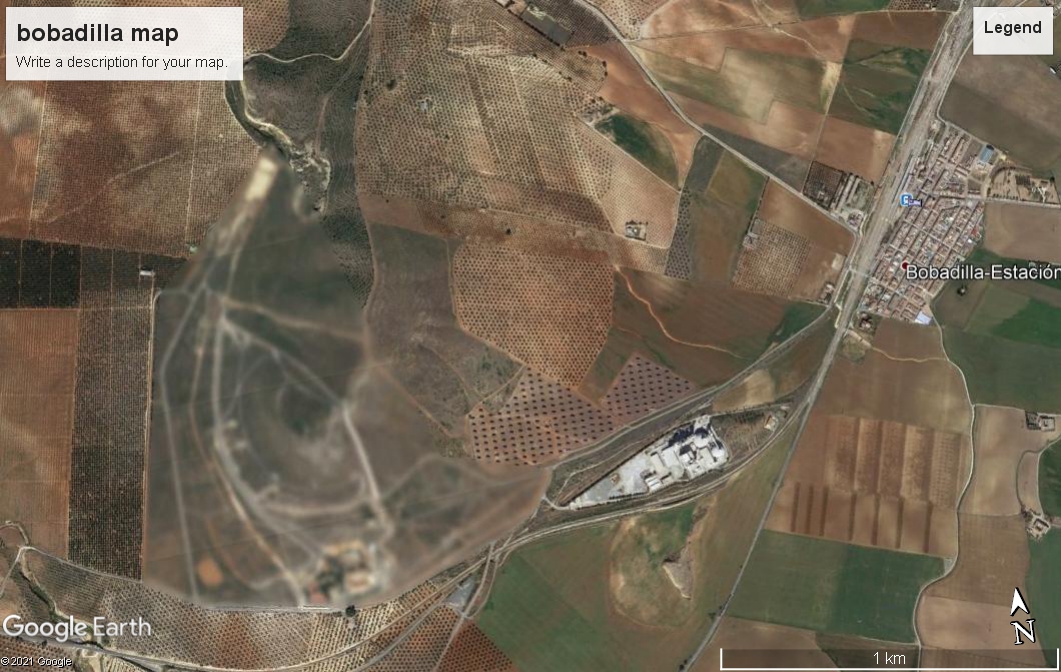
The base was first constructed in the 30’s with wooden bunkers, storing Italian and German supplied explosives to be used in the Spanish Civil war. Bobadilla is at the nexus of several rail systems, and if you wanted to store weapons that could be shipped anywhere in Andalucia within a day, you would put them at Bobadilla. In 1943 a Madrid based construction company was awarded the task of digging a tunnel into the hillside for the storage of shells, incendiaries and ammunition. More than a thousand people worked on the project using a hundred mules to carry the excavated rock to a huge dump to the north of the base. A military camp was then constructed by the railway lines, and the explosives began to arrive by road and rail to be stored in the tunnels. Eventually, the subterranean part of the base was enlarged with four tunnel entrances and a network of interconnected chambers deep inside the hill.
Today it is a storage area for the high tech munitions used by the Ejército del Aire (Spanish Air Force) and manned by a garrison that have at their disposal the most sophisticated, state of the art, surveillance cameras, as would be expected in this modern world of terrorist threats. The watchtower atop the hill above the tunnels has a 360 degree view of the entire base and surrounding countryside. Vigilance is the order of the day, but 24 hour surveillance can be very boring. Long shifts watching the fences through cameras, when there is nothing more interesting to see than rabbits can be soul destroying. Apart from the odd weekend leave, the only other entertainment is the camp bar and a tennis court. To be stationed at Bobadilla could make a posting there seem more like a punishment rather than a career move.
On the night of the 9 May 2010 everything changed for the base at Bobadilla. Early in the morning the duty personnel were startled when all their camera screens went white. At the same time, the phones linking the watchtowers burst into life as the soldiers manning them shouted their reports. A bright, hovering light that changed shape as it moved began to systematically inspect the base area. The officer in charge scrambled the duty watch, who armed themselves with assault rifles and drove out in all-terrain vehicles to follow the light. Finally, after twenty minutes, the bright object expanded and disappeared.
Everything was hushed up, and within hours, the camp commander gathered all the eyewitness accounts and videotapes of the object. Everybody was warned to say nothing about the event. When he reported the night's events to his superiors, the base commander was summoned to Madrid to present his report.
However, somebody had used their mobile phone to record the CCTV screens, recording the antics of the object. Two years later, the video found its way to Juan Fran Romero, a writer, who investigated further and asked questions in the village of Bobadilla, the Policia National and at the nearby cement works, where they also have CCTV. Nobody else saw anything that night. He is convinced that the object in the video was a genuine UFO and not Venus out of focus or a low flying aircraft. This one incident might be passed off as a prank, but this is not the only UFO sighting at the Bobadilla base. eventally the video was shown on Spanish television and I include the utube link here
http://www.youtube.com/watch?v=sCx-B1L33XY 9th Feb 2012
Seemingly in the70’s somebody took photographs of a group of lights in the sky over the base. Eyewitness reports came in from soldiers who had served on the base describing actual sightings of strange creatures inside the tunnels. The soldiers talk of seeing a human shaped creature just over a meter tall with red eyes, which confidently faced the armed troops down. When the soldiers released the safety catches on their weapons and took aim, the creatures disappeared. On reporting this encounter to their superior officer they were curtly told that they had seen nothing and never to speak of it again to anyone. Other reports speak of glowing diffuse green lights within the area of the base. On other occasions, whilst on patrol in the base area, soldiers have seen the same small figures furtively moving amongst the trees, but were too frightened to get out of their jeep and investigate, even though they were armed.
Soldiers driving a wagon within the compound found a strange lizard, which they captured and put in a wooden box. The creature was about 40 cm. tall and stood on its hind legs. It had strong jaws and powerful claws and could make vocal sounds. When they showed their captive to the officer of the watch he confiscated it, and within a few hours an unmarked helicopter arrived and took the creature away.
Similar eyewitness reports from American soldiers at the nearby airbase of Moron describe the same, small, human shaped creatures moving within the base area as teams of soldiers combed the dense brush trying to find them. Before morning, the area where the strange beings had been seen had mysteriously caught fire, and all trace of their existence obliterated.
The Bobadilla base has become the equivalent of Area 51 in the United States in eyes of Spanish conspiracy theorists. I don´t know whether to believe the stories or not, but I think that a posting to Bobadilla now would be a chance to be in on the front line of a totally different world, or to be part of a huge hoax. Either way, you would be guaranteed free beers for years to come.
 4
Like
Published at 9:25 AM Comments (1)
4
Like
Published at 9:25 AM Comments (1)
Wooly thinking
Friday, April 9, 2021
According to a news article in the Guardian, Pre-Covid Spain had been hit by a falling population and empty rural towns. Castilla, Galicia and Leon have more than 3,000 abandoned villages. The owners of the land have disappeared and records of ownership, which would have been patchy at best, are now gone forever. The old have moved to the towns to be nearer to hospitals and their children. The infrastructure of roads and transport that would have served the isolated villages is gone, and many of the roads are impassable. The population prediction for Spain is gloomy, with an expected 50% fall in population by 2100. Other countries in Europe are seeing the same fall in populations and overall an area of land the size of Italy will have been abandoned by 2030.
But there is an upside to this story. Forests that had been cut down for agriculture have grown back, and records for Galicia show that the 1900 forest cover of 8% has grown to 25%. As the villages empty, the farmland returns to nature. France, Italy and Romania have shown even greater reforestation in recent decades.
At the turn of the first century, the forest cover in Spain was much greater, and this re-wilding has reversed a centuries long war against the Spanish woodlands that was brought about by an inoffensive Moorish immigrant.
When Marin ibn Wartajan al-Zenati became leader of a nomadic tribe in the Atlas Mountains of Morocco he gave the tribe his name. From then on, they were called the Marinids. They were nomadic because of the unique breed of sheep that they kept required to be moved between the high summer pastures in the mountains and the winter pastures in the river valleys. With the arrival of the Arabs in the 11th and 12th centuries, the Marinids moved to the north-west of present-day Algeria, before migrating en-masse into Morocco at the beginning of the 13th century, where they began to challenge the ruling Almohads for dominance.
When the Marinids, now led by Abu Yusuf Yaqub, had subdued the last of the Almohad outpost of Marrakech, they turned their attention on al-Andaluz. Abu crossed the straits, took control of the isolated Almohad taifas in al-Andaluz, and formed an alliance with the Nazrids to defend and enlarge Muslim controlled parts of Iberia. When they invaded, the Merini farmers who followed the warriors brought their sheep with them and, of course, this novel animal to Spain was called the Merino.
 Photo: Shutterstock. Photo: Shutterstock.
The reconquest raged back and forth, and eventually the Moors were driven out of most of Spain. But Christian farmers liked the Merino’s fine wool, so they adopted it, as well as the same nomadic existence as the Berbers had lived in Africa.
In 1273 King Alfonso X created the Mesta, which was an association for sheep farmers. At first sight this seems to be a trivial innovation, but it came at a time when the traditional dominance of the English woollen trade had slumped. By coordinating the efforts of the nomadic Castilian pastors, Alfonso rejuvenated exports of Castilian wool to all Europe, and this vital clothing commodity became his kingdom’s biggest export, earning it the name of “oro blanco.” Flax had been the commonest fibre for clothmaking until then, but wool proved to be a much warmer and more versatile replacement. The long fibres could be spun into fine threads that, when woven, gave a closer weave, which to a certain extent, gave a more waterproof cloth. It was also much less coarse when worn against the skin.
Alfonso was a very clever king, and he was well aware that for every bale of wool that was exported, he received a tax payment. Organising the shepherds into a co-op would ultimately be to his benefit. By 1476, Queen Isabel and her husband King Ferdinand were the owners of extensive flocks of their own Merinos, and Isabel was made Grand Master of the Mesta. Fifty years later, there were three and a half million Merinos in Spain.
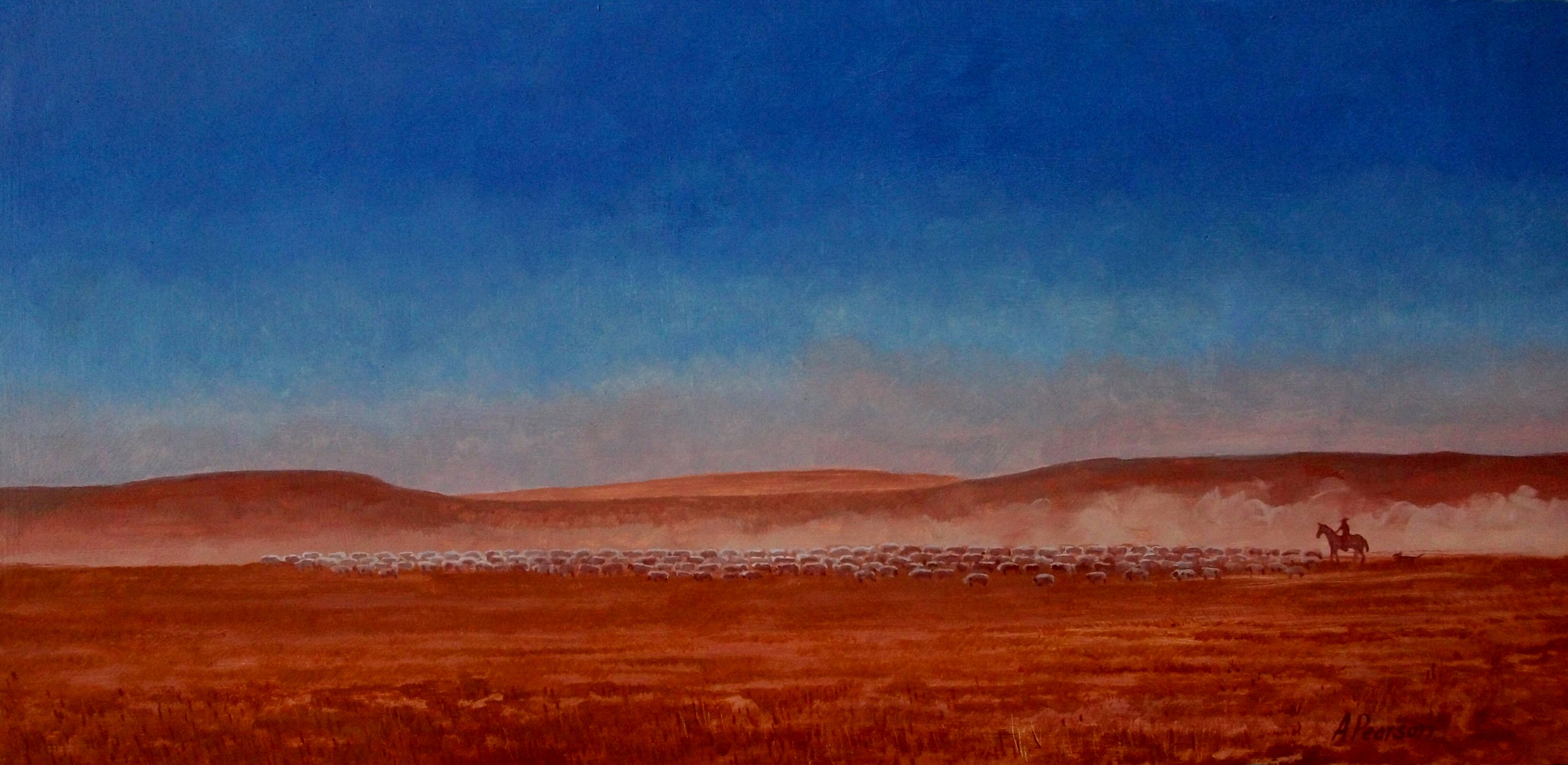
Painting: Pastoral, Alan Pearson. alanpearson.pixels.com
The problem was that the highland summer pastures in Spain were 500 miles from the lowland pastures. This meant a twice yearly trek for the shepherds, and it was important that the huge flocks of sheep had good grass to graze on during their month-long journey. By 1500’s, the Moors were gone from Spain, and the southern pastures of Andalucia were opened to summer grazing for the Merinos . The bi-annual migrations now involved huge numbers of sheep, and they followed well-known tracks of cleared land called cañadas so that the sheep had enough to eat on their trek. As the flocks became bigger the cañadas s were widened and forests were cut back to clear more land. The cañadas s grew to be a hundred meters wide, and farms on either side of the tracks were forbidden to fence their lands so that the sheep could graze. The Mesta, now controlled by the crown, requisitioned more land for the cañadas and for the Merino’s summer pastures in the mountains. Any farmer who refused to give his land faced the death penalty. The forests were cleared and the cañadas ran like a ribbon down half the length of Spain. In the lowlands, the shepherds were given permission to cut the young shoots of the trees and feed them to the sheep, preventing further growth, and by the middle of the sixteenth century much of the forests that covered central Spain was gone. Over large areas the land was treeless, and winter storm erosion removed the topsoil leaving rocky barren hillsides. The agriculture of Spain has not recovered to this day.
Modern Spain’s human populations may be falling, but wild animal populations are increasing. Populations of wild boar and roe deer have risen steeply, which means that the large carnivorous predators that feed on them are on the increase, too, and in Galicia’s case, the brown bear has been seen again after an absence of 150 years.
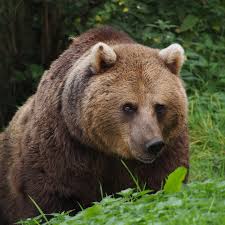 Brown Bear, Photo: Wiki. Brown Bear, Photo: Wiki.
Spain in general has seen the resurgence of the Iberian wolf, and although wolf hunting has been banned throughout southern Spain, the wolf population there is practically nonexistent. Recently, the ban has been extended to the north-west, where there is a significant population of between 2000 and 2500 wolves in 290 packs. This is the largest wolf population in Europe, but in the mid-nineteenth century it numbered as many as 9,000.
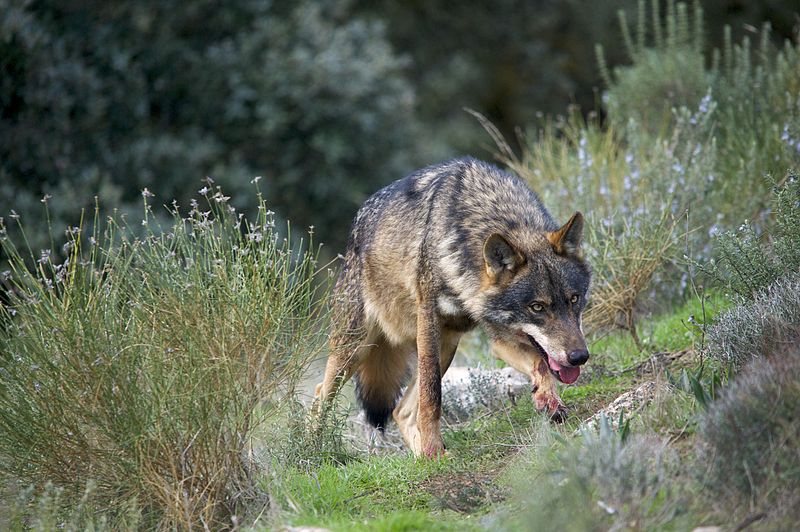
Photo: Aturo de Frias Marques
A program of culling reduced the number to 400 and confined their population to Castilla and León, but the deliberate poisoning of wolves was banned in the 1970’s and since then their numbers have risen dramatically. When the ban was lifted, only Castilla and León, Asturias and Cantabria objected. In these areas the annual loss of livestock to wolves is now around 15,000 animals at a cost of 5.5 million euros. At the moment there is unrest about lifting the ban, but not all the farmers are against it.
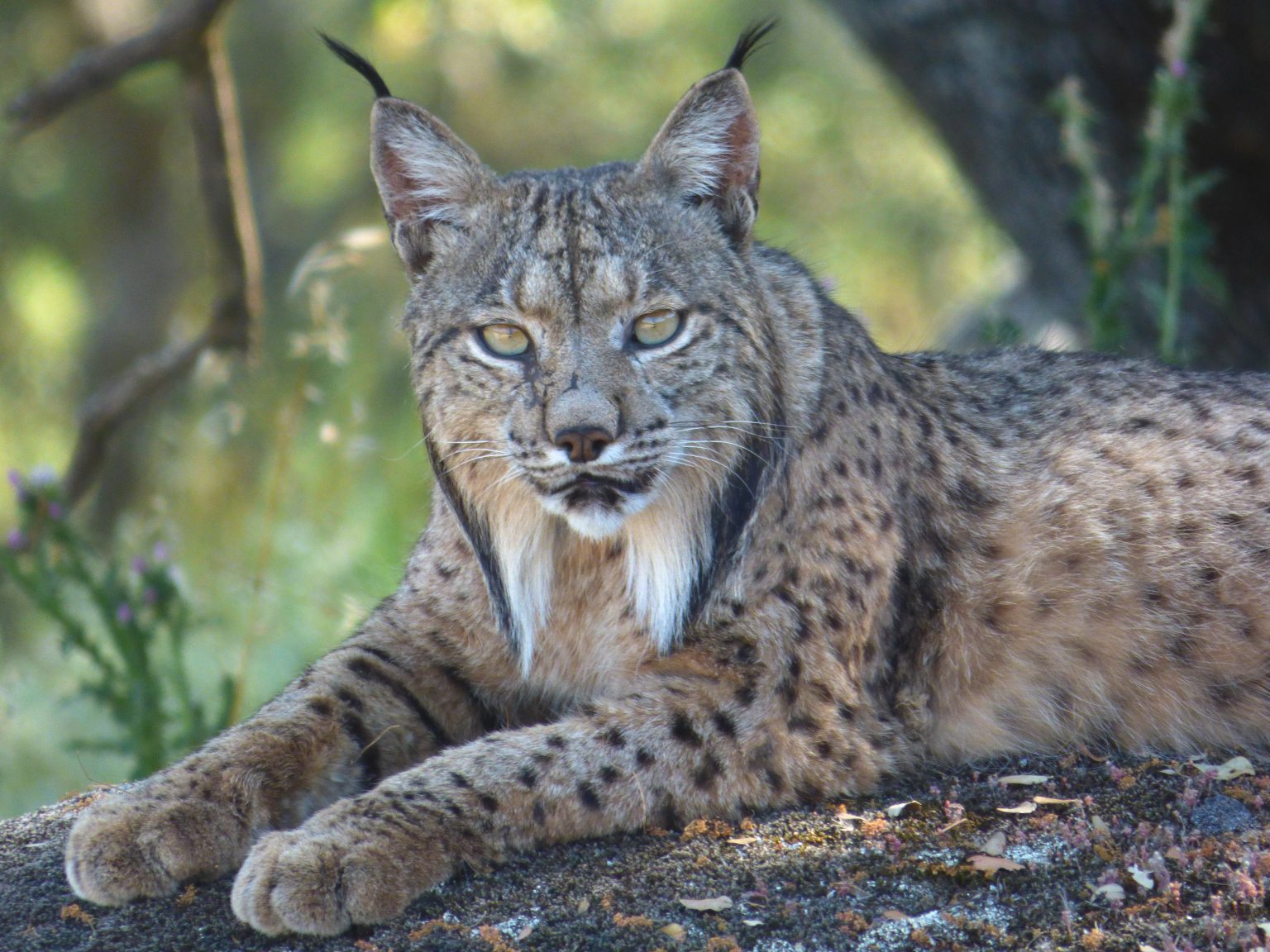
The lynx and wolverine populations have shown similar rises.
Even though the Lynx rarely makes headlines, a mention in the television series “Seven Worlds, One Planet,” brought it to the attention of 7 million viewers. The Lynx is at the top of the food chain as a carnivore, and as such has no predators to worry about, but it has been suffering losses because of road traffic incidences, with 35 of the cats being killed in 2019. The region has an estimated population of 830 Lynx, and has a healthy growth rate to replace the losses, but conservation groups have organised the building of culverts and ecoducts which allow lynx to pass underneath busy highways that cross their territories with signs posted along the roadsides to alert drivers to their presence.
The Covid pandemic can only have increased the number of people abandoning the country as unemployment in general and the collapse of rural agriculture will accelerate the amount of land abandoned to nature again. What has been a bad year for humans could turn out to be a good year for Spain’s wild animals.
 5
Like
Published at 9:22 AM Comments (2)
5
Like
Published at 9:22 AM Comments (2)
Spam post or Abuse? Please let us know
|
|